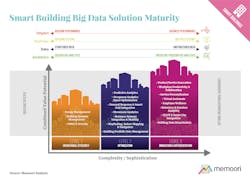A weekend of finding a sharable car on local streets in an Uber-less city created some fascinating discussions about the value of actual car ownership (a calculation made even more complex thanks to city parking logistics). These thoughts caused me to reflect on what it all might mean to our new approach to Building Data; how will we capture and harness the power of the immense amount of data generated by smart buildings?
Do we really want to own our workspace? Or do we want to match our workspace to our daily location, purpose and resource base?How do we monetize our Building Data to attract and interact? How do we create greater value from our data? Location services will identify the potential of workspace opportunities to share space for more revenue. As buildings move to this model we need to future proof them with standards, common databases, and yes, API.How do we get to level three? (See graphic below.)This Memoori article Demonstrating Smart Building Business Value Further Up The Chaincomes with these wise words and a great graphic on our solution maturity:The business case for smart buildings must be clear, offering a more quantifiable return on investment (ROI) and more tangible benefits — not just a vision of a happy, healthy, productive workplace.How is the smart building shared space changing? Wayfinding, Indoor Mapping and Navigation is a hot space. Those are the essential building blocks needed to make indoor spaces information-rich and helpful: mapping, positioning, analytics and development.
Jibestream, a Canadian provider of experiential wayfinding software and mapping technologies was acquired by Inpixon, an indoor positioning and data analytics company. The Jibestream solution is a full-featured geospatial platform that integrates business data with high-fidelity indoor maps to create smart indoor spaces. this Q3 Overview of Acquisitions in the Smart Buildings Space provides great insight:
Our buildings and cities are becoming intelligent & highly-connected, designed to support healthy, open, productive societies. However, they collectively neglect the major issues looming over their futures. Shared challenges are best solved through collaborative solutions and with indiscriminate groups of cities around the world facing similar existential issues, we should find a new way to work together to redefine urban planning for the 21st century. What buildings and cities will look like with this new direction will depend on the world’s best brains working together with open minds.
Here’s yet another Memoori article that discusses how far we still have to go, The Biggest Urban Challenges are being Ignored in the Smart City Agenda.
As you may have noticed, I am a big fan of the insights of James McHale, Managing Director, Owner & Founder of Memoori, and Daphne Tomlinson, their Senior Research Associate. Memoori is a consultancy company based in Stockholm that provides independent market research, business intelligence and advice on Smart Building technologies. These two are doing a great job of painting the future.
They share a lot of innovative possibilities, such as renting out daytime workspace that shares a high-end, evening-only restaurant in a prime downtown location during the day. (Step into my booth, the coffee and snacks are amazing and the ambiance the best! Oh, and we need to be done by 5:00 or the conference room becomes a supper reservation!) Can you see how new value can be created from sharing the Data, Work-Space, Interaction, and Integration?
Local drive-and-drop car sharing is built on the Uberization model and cries out for the autonomous vehicle to continue the journey back to a safe parking spot. This leads to the natural question, why do I have to go to the car? Why does the car not come to me? It is not likely our buildings are going to move towards us anytime soon, but I think the local car-sharing model is a good one to follow for a new look at workspace sharing. When the folks come to share our workspace we need more data simply presented in a format that today's world understands.
They want to know what the space looks like and how will location services help me and my clients find it. Is it environmentally friendly? Is it part of the city climate emergency plan? Is it a healthy space? Can I control environment attributes (temperature, IAQ, noise, lighting, natural light etc.)? Do the chairs have a seat heater? And is it a chair or a ball or a trapeze? Can I access and interact with the space through my phone?
In this model, I see the building owner/occupier bidding for his own space. If it is more valuable to others, then the owner will sell it and buy space in a location that’s a better fit.
So selling the space online and exposing our data to everyone is an important part of the service.
Data, data, we need data now! We need it here, there and everywhere in a simple format we can understand, and all of it accessible on our phones.
We need to keep the focus on creating the autonomous building that shares its space and resources with all users.
The autonomous smart building is the secret formula for Smart City Building.
In a recent discussion with Sudha Jamthe of IoT Disruptions CEO, Industry Advisor, Author and Stanford CSP Instructor for IoT, Self-Driving Car Business San Jose, California I quote her saying:
The good news is that we have decades of experience building shared spaces with buildings and automating buildings is bringing us closer to a glimpse of what a shared mobility space in an AV will look like.
I share more of my thoughts in this ControlTalk NOW Interview. I discussed the theme of the October issue of AutomatedBuildings.com, Building Backbone, as well as Wireless Skin.
The challenge, excitement and the mind-bending Internet of Things journey we all share has us all using the same tools. Developing User experience standards is huge and will allow us to future proof our rapidly moving evolution.
Below are some great captures about building Data and UX from several sources.
First from, AutmatedBuildings.com's Contributing Editor Marc Petock, Chief Communications Officer, Vice President, Marketing Lynxspring & Connexx Energy:
Today’s built environment comprises rich streams of data. Capturing and properly harnessing this data allows building owners and occupants to better manage risk and create ‘smart’ buildings. Data will never come from a single unified source. We must understand that data and its practical value originates from just about anywhere. The challenge is that it must be organized, facilitated and orchestrated to capitalize on its value. Data alone is useless; the value comes from the insights it uncovers. However, in general, these insights are not the result of smarter algorithms, they are not the result of more data but ---the right data. The future continues to be driven by open standards. This also applies to data. Adoption of an open data management and systems procurement strategy ensures a much greater degree of flexibility for the future integration of new systems and applications into the smart building, as well as reducing operational costs and the implementation of time and overall complexity of building architectures.
This next from Emmanuel Daniel, who discusses strategy in, Digitally Transforming Microsoft's Global Real Estate Portfolio:
Everything is seamless, from the way you get to the campus (whether driving, carpooling or public transit) to entering the building and accessing the services within it. That's just one example, and it extends to any campus building and any connected activity, whether it's finding people, organizing your day, eating, having quiet time or physical activity. The goal is to create a campus where you can be the most productive version of yourself while also maintaining a balance of physical and emotional wellbeing. The beauty of it is we can create a service that anybody can use anywhere in the world - and they believe that service was specifically designed for them.
B. Scott Muench writing on the www.j2inn.com blog talks about How to Create a Good User Interface:
In the technology world, it doesn’t matter what you’re building or who will use it, the user experience and interface is of utmost importance. If users can’t figure out how to navigate your product and/or don’t have a positive experience, they will never realize its full capabilities, and you will risk losing customers. In the BAS space, a poor interface ends up becoming a burden on your building’s efficiency and on engineers and system integrators as they have to constantly field questions from end users.
Quoting from Transforming Automation User Experience by Troy Harvey, CEO PassiveLogic:
User experience or ‘UX’ is the fundamental pursuit of all human-interactive technology. There is no larger market for human-centric technology than the world’s buildings infrastructure. The human race first walked out of caves laboring to build structures, places of habitation, environments of assembly, marketplaces for commerce, and the cities to house them — all in the pursuit of a better quality of life. Indeed, the very nature of the built environment and study of architecture is fundamentally the oldest pursuit of “user experience.”
Workspace research consultants Verdantix have just published an independent analysis and comparison of leading space management tech vendors. On average, 40% of office space is unoccupied on any given day, rising to 60% including unoccupied desks.
Anish PK, Senior Consultant, IoT for Buildings has some important things to day about Smart Metering and Its Importance in Shaping an IoT Enabled Smart City:
One of the key outcomes of implementing smart metering is the availability of rich data. The smart metering creates a useful data source; the customer/citizen energy spending data. Yes as we all know the data has got more power than ever before as it is now considered as the major pillar in framing any policy or strategy.
We hope this discussion inspires more amazing thoughts from all of you. Please share your thoughts with me [email protected]
About the Author
Ken Sinclair
Editor/Owner/Founder
Ken Sinclair has been called an oracle of the digital age. He sees himself more as a storyteller and hopes the stories he tells will be a catalyst for the IoT future we are all (eventually) going to live. The more than 50 chapters in that ongoing story of digital transformation below are peppered with HTML links to articles containing an amazing and diverse amount of information.
Ken believes that systems will be smarter, self-learning, edgy, innovative, and sophisticated, and to create, manage and re-invent those systems the industry needs to grow our most important resource, our younger people, by reaching out to them with messages about how vibrant, vital and rewarding working in this industry can be.

